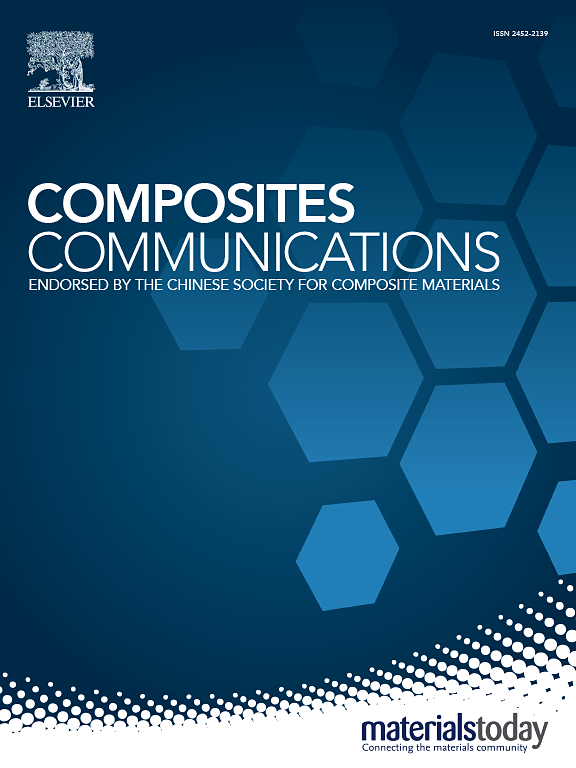A resin-based perforated sound absorption composite reinforced with polyethylene geotextile: Research on UV resistance, aging resistance, chemical corrosion resistance, thermal stability and wear resistance
IF 7.7
2区 材料科学
Q1 MATERIALS SCIENCE, COMPOSITES
引用次数: 0
Abstract
Due to the widespread distribution and difficulty in controlling noise sources, the practical application of sound-absorbing materials is constrained by environmental factors. Responding to growing demands for multifunctional composites, this study developed a perforated HGM/PU composite through textile coating and laser perforation techniques. The composite employs hollow glass microspheres (HGM) as functional fillers, waterborne polyurethane (PU) as the resin matrix, and polyethylene short-fiber geotextiles as reinforcement. The HGM establishes cavity structures within the material to enhance resonance absorption, while simultaneously scattering incident sound waves to extend transmission paths and improve sound absorption efficiency. Orthogonal experimental design was adopted to investigate parametric effects on sound absorption performance. The optimized composite achieved a peak sound absorption coefficient of 0.83 at 4169 Hz. Additionally, the composite exhibits exceptional UV resistance (T(UVA)AV = 0.77 %, UPF >100) and thermal stability (94.75 % mass retention at 400 °C). After thermal aging, the sound absorption coefficient decreased by only 3.08 %. This work successfully demonstrates a multifunctional perforated sound-absorbing composite with integrated properties including UV resistance, thermal aging resistance, and short-term chemical corrosion resistance.
聚乙烯土工布增强树脂基穿孔吸声复合材料:抗紫外线、耐老化、耐化学腐蚀、热稳定性和耐磨性研究
由于噪声源分布广泛且难以控制,吸声材料的实际应用受到环境因素的制约。为了满足日益增长的多功能复合材料的需求,本研究通过纺织涂层和激光穿孔技术开发了一种穿孔的HGM/PU复合材料。该复合材料采用中空玻璃微球(HGM)作为功能性填料,水性聚氨酯(PU)作为树脂基体,聚乙烯短纤维土工布作为增强材料。HGM在材料内部建立腔体结构,增强共振吸收,同时散射入射声波,延长传播路径,提高吸声效率。采用正交试验设计研究了各参数对吸声性能的影响。优化后的复合材料在4169 Hz处的峰值吸声系数为0.83。此外,该复合材料还具有优异的抗紫外线性能(T(UVA)AV = 0.77%, UPF >100)和热稳定性(400°C时质量保持率94.75%)。热老化后,吸声系数仅下降3.08%。这项工作成功地展示了一种多功能穿孔吸声复合材料,它具有抗紫外线、抗热老化和抗短期化学腐蚀的综合性能。
本文章由计算机程序翻译,如有差异,请以英文原文为准。
求助全文
约1分钟内获得全文
求助全文
来源期刊

Composites Communications
Materials Science-Ceramics and Composites
CiteScore
12.10
自引率
10.00%
发文量
340
审稿时长
36 days
期刊介绍:
Composites Communications (Compos. Commun.) is a peer-reviewed journal publishing short communications and letters on the latest advances in composites science and technology. With a rapid review and publication process, its goal is to disseminate new knowledge promptly within the composites community. The journal welcomes manuscripts presenting creative concepts and new findings in design, state-of-the-art approaches in processing, synthesis, characterization, and mechanics modeling. In addition to traditional fiber-/particulate-reinforced engineering composites, it encourages submissions on composites with exceptional physical, mechanical, and fracture properties, as well as those with unique functions and significant application potential. This includes biomimetic and bio-inspired composites for biomedical applications, functional nano-composites for thermal management and energy applications, and composites designed for extreme service environments.
 求助内容:
求助内容: 应助结果提醒方式:
应助结果提醒方式:


